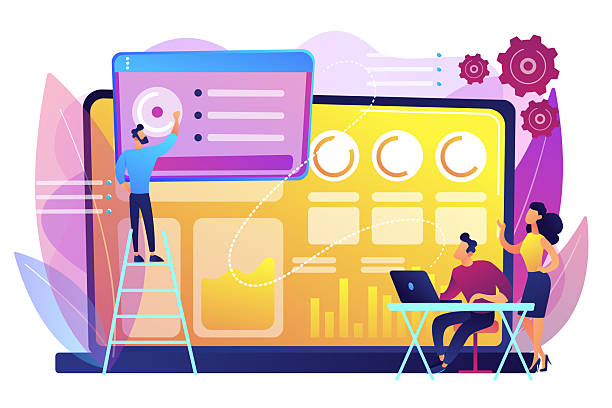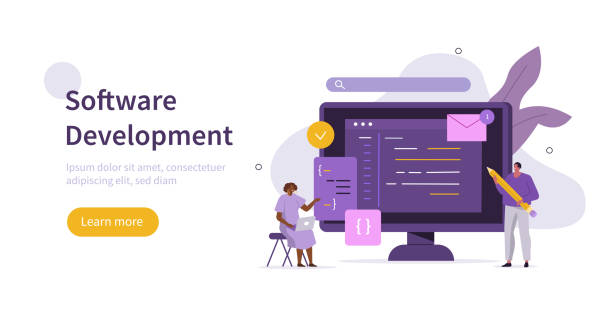Introduction and Importance of Secure Website Design
In today’s digital world, where daily life and businesses are heavily reliant on online spaces, secure website design is no longer a luxury, but a vital necessity.
This process involves a set of measures and techniques whose ultimate goal is to protect sensitive user data and website information against #cyber_attacks and #security_breaches.
An insecure website can lead to loss of reputation, financial damages, and even legal prosecution.
The importance of #cybersecurity is so high that even a small breach can have disastrous consequences.
Suppose an e-commerce website is attacked and customers’ credit card information is stolen; this incident not only causes irreparable damage to the store’s reputation but also reduces public trust in online purchases.
Secure website design not only means preventing unauthorized access but also includes ensuring the stability and availability of the website against Denial-of-Service (DDoS) attacks.
This field is constantly evolving, and with the emergence of new threats, novel security approaches are also being developed.
Therefore, it is essential for developers and website administrators to always keep their knowledge updated.
Understanding that secure website design is a continuous process, not a one-time step, is crucial for every organization and individual operating online.
This explanatory and educational section will help you gain a better understanding of why this topic is important and build the necessary foundation for further discussion.
Does your current corporate website present a worthy image of your brand and attract new customers?
If not, turn this challenge into an opportunity with Rasaweb’s professional corporate website design services.
✅ Significantly improves your brand’s credibility and image.
✅ Paves the way for attracting leads and new customers.
⚡ For free and specialized consultation, contact Rasaweb now!
Common Website Security Threats
Do you know what the most common security threats targeting websites are and how to prevent them? This is a thought-provoking and specialized content that addresses various aspects of cyberattacks.
The web world, despite all its advantages, is constantly exposed to numerous threats that can jeopardize website security.
Among the most common of these threats are SQL injection attacks, Cross-Site Scripting (XSS), Brute Force attacks, Phishing, and Denial-of-Service (DDoS) attacks.
Secure website design requires a deep understanding of these threats.
An SQL injection attack occurs when an attacker attempts to access or modify a database by inserting malicious code into website input fields.
This attack can lead to the theft of sensitive information or even a complete website shutdown.
XSS also allows attackers to inject malicious scripts into web pages, which then execute in the victim’s browser and can steal session information or cookies.
Brute Force attacks attempt to guess usernames and passwords through repeated and systematic attempts.
Phishing, usually carried out by designing fake web pages, aims to deceive users into revealing confidential information.
DDoS attacks also take down websites by overwhelming the server with fake traffic.
Understanding these threats and how they work is the first step towards secure website design and secure web development.
Countering these threats requires a combination of technical solutions, user awareness, and precise security policies.
Analyzing these threats helps us adopt more effective strategies for protecting websites against vulnerabilities.
Basic Principles of Secure Website Design
To achieve a secure website, adhering to basic principles in secure website design is crucial.
This guiding and educational section will help you become familiar with the most important of these principles.
The first and perhaps most important principle is the use of the HTTPS protocol.
HTTPS (Hypertext Transfer Protocol Secure) encrypts the communication between the user’s browser and the website server, preventing information eavesdropping by third parties.
This action not only ensures data security but also helps with website SEO, as search engines prefer HTTPS websites.
The second principle is Input Validation.
Any data entered by the user must be carefully validated before processing on the server.
This prevents attacks such as SQL injection and XSS.
The third principle is proper password management.
Websites should encourage users to use strong passwords and store passwords as hashed values with a Salt in the database.
Using Two-Factor Authentication (2FA) also significantly enhances security.
Regular updates of software, plugins, and Content Management Systems (CMS) are also of high importance, as older versions often have known vulnerabilities that can be exploited.
Also, restricting access based on the Principle of Least Privilege means that every user or system should only have access to the resources necessary to perform their tasks.
These principles form the backbone of secure website design and website protection, and adhering to them is essential for any website.
Below is a table of basic security measures:
| Security Measure | Description | Importance |
|---|---|---|
| Use of HTTPS | Encrypts communication between user and server | Very High, protects data and improves SEO |
| Input Validation | Sanitizing and thoroughly checking input data | Prevents SQL injection and XSS attacks |
| Strong Password Management | Using hash and salt, two-factor authentication | Protects user accounts |
| Regular Updates | Software, Plugins, and CMS | Patches known vulnerabilities |
| Access Restrictions | Principle of Least Privilege for users and systems | Reduces risk of unauthorized access |
Choosing Secure and Up-to-Date Technologies
In the process of secure website design, choosing appropriate and up-to-date technologies is of high importance.
This is a specialized discussion and guide that developers should pay special attention to.
Using modern web frameworks like Django (for Python), Laravel (for PHP), Ruby on Rails (for Ruby), or Express.js (for Node.js) can significantly help increase website security.
These frameworks typically have built-in security features to combat common threats such as CSRF (Cross-Site Request Forgery), XSS, and SQL Injection.
By using these tools, developers spend less time implementing basic security mechanisms and can focus on business logic, while a powerful security layer is provided by the framework.
In addition to frameworks, choosing the right programming language is also important.
Some languages, like Rust, due to their inherent features in memory management and prevention of common errors, can help in developing more secure software.
Also, for data storage, it is essential to use databases that provide strong security mechanisms for encrypting data at rest and in transit.
PostgreSQL and MongoDB are examples of databases that, with proper configuration, can provide high security.
Correct selection and configuration of the web server (such as Nginx or Apache) and operating system (such as Linux) also play a significant role in the overall security of the website.
It is always necessary to use the latest stable and secure versions of these software and change default settings that may have vulnerabilities.
Secure website design is a comprehensive process that covers everything from the coding layer to the server infrastructure, and informed technology selection is the cornerstone of this security.
Did you know that 94% of users’ first impressions of a business are related to its website design? With professional corporate website design by **Rasaweb**, turn this initial impression into an opportunity for growth.
✅ Attract more customers and increase sales
✅ Build credibility and trust in the audience’s eyes⚡ Get a free website design consultation!
User’s Role in Website Security
Have you ever thought about how prominent your role as a user is in maintaining the security of the websites you use? This is an educational and thought-provoking content that addresses user responsibilities.
Often, the focus is on secure website design and security measures by developers, but it should not be overlooked that users are also an important part of the cybersecurity chain.
Weaknesses in user behaviors and security habits can weaken even the strongest website defense.
One of the most important user responsibilities is to use strong and unique passwords.
Weak and reused passwords, along with the lack of two-factor authentication (2FA), open the door to Brute Force and Credential Stuffing attacks.
Users should use complex passwords including uppercase and lowercase letters, numbers, and symbols, and avoid reusing them across different websites.
Using a Password Manager can be very useful in this regard.
Awareness of phishing attacks is also crucial.
Attackers often try to trick users into revealing confidential information by sending fake emails or designing similar web pages.
Users should always check the URL and avoid clicking on suspicious links.
Installing reputable antivirus software and regularly updating the operating system and web browser also contribute to user security.
Furthermore, vigilance against online scams and avoiding downloading unknown files or clicking on suspicious advertisements are part of users’ security responsibilities.
Secure website design alone is not enough; user cooperation and awareness in protecting personal and collective information complete this puzzle.
By educating and raising awareness, we can have a safer online community.
Click here to preview your posts with PRO themes ››
Penetration Testing and Security Assessments
One of the key steps in secure website design and maintaining its security is regular Penetration Testing and security assessments.
This is a specialized and analytical content that addresses vulnerability discovery methods.
Penetration testing is essentially a simulated and controlled attack on a website performed by security experts or ethical hackers to identify potential weaknesses and vulnerabilities before real attackers discover them.
This process involves various stages, including information gathering, vulnerability scanning, exploiting weaknesses, and reporting.
The ultimate goal of penetration testing is to provide a comprehensive view of the website’s security posture and practical recommendations for improvement.
In addition to penetration testing, automated vulnerability scans are also important tools that can be regularly used to identify known weaknesses.
These tools can quickly review large volumes of code and detect common vulnerabilities, although they are not a substitute for manual penetration testing.
Conducting Security Audits periodically can also be beneficial.
These audits not only cover the technical aspects of secure website design but also examine the organization’s security policies and procedures to ensure that all cybersecurity aspects are considered.
Companies should regularly and systematically conduct these tests and assessments, especially after any major changes in website architecture or the addition of new functionalities.
The results of these assessments should be taken seriously, and discovered vulnerabilities should be addressed as soon as possible.
This proactive approach is an integral part of a comprehensive strategy for secure web development and significantly helps maintain user trust and business stability.
Continuously performing these processes ensures the long-term security of the website.
Data Backup and Recovery
One of the critical and often overlooked aspects of secure website design is meticulous planning for Backup and Disaster Recovery.
This guiding and explanatory section shows you why this topic is important and how to implement it.
Even with the strongest security mechanisms, there is always a possibility of unforeseen incidents such as successful cyberattacks, hardware failures, human error, or natural disasters.
In such circumstances, having an effective data backup and recovery strategy can make the difference between complete data and business loss, and fast and complete operational recovery.
Backups should be performed regularly and automatically.
These backups should include all website data, including source code files, database, images, and any other files related to the website.
It is recommended that backups be stored in separate and secure locations (e.g., in the cloud or on physical servers away from the main website) so that if the main server is lost, the backups are not also lost.
In addition to backup, periodic testing of the recovery process is also of great importance.
A backup is useless if it cannot be successfully restored.
Therefore, the recovery process should be regularly simulated and tested to ensure its effectiveness.
Developing a comprehensive Disaster Recovery Plan (DRP) that includes detailed steps for recovering systems and data after an incident is also very essential.
This plan should include specific responsibilities, tools, and timelines.
Ultimately, secure website design is not just about preventing attacks, but also includes the ability to return to normal operation after an attack or disaster.
This readiness to deal with emergencies is a key element in ensuring the stability and user trust in your online services.
A website with a strong backup system will be able to continue operating even after the worst-case scenarios.
Below is a table of the best backup methods:
Click here to preview your posts with PRO themes ››
| Method | Description | Advantages |
|---|---|---|
| Full Backup | Complete copy of all data | Easy and fast recovery, minimal complexity |
| Incremental Backup | Only data changed since the last backup (full or incremental) | Less space consumption, faster backup speed |
| Differential Backup | Only data changed since the last full backup | Relatively fast recovery, moderate space consumption |
| Off-site Storage | Storing backups in a separate physical or cloud location | Protection against local disasters |
| Recovery Testing | Simulating the data recovery process | Ensuring backups are usable |
Facing Cyber Attacks: News and Reactions
News related to cyberattacks on large websites and organizations has unfortunately become a common phenomenon.
This news and entertaining section examines examples of these attacks and how reactions unfold.
Secure website design, though essential, is not 100% impenetrable.
In recent years, we have witnessed widespread attacks on reputable companies such as Equifax, Yahoo, Marriott, and even government websites, leading to the disclosure of millions of user data.
These incidents demonstrate that even with massive investments in cybersecurity, attackers are constantly finding new ways to circumvent defense mechanisms.
One of the most controversial aspects is how companies react after discovering an attack.
Speed and transparency in informing users, providing solutions to protect disclosed information (such as offering credit monitoring services), and conducting comprehensive investigations to identify the root causes of the problem are among public expectations.
Some companies have performed better in this regard, while others have faced severe criticism.
For example, in the case of the Equifax breach, a lack of transparency and delay in public notification led to a significant loss of trust.
On the other hand, some companies, with quick reactions and decisive actions, have managed to partially mitigate the negative impact of the attack.
These stories, though bitter, carry valuable lessons.
They emphasize the importance of preparedness for worst-case scenarios, continuous investment in secure website design and cybersecurity, and developing incident response plans.
Furthermore, these events play a significant role in raising public awareness about the risks of the online space and users’ responsibilities in maintaining their own security.
Observing and analyzing this news can be very insightful for a better understanding of the real challenges in the field of cybersecurity.
Does your current e-commerce website design not generate the expected sales for you?
Rasaweb is an expert in professional e-commerce website design!
✅ An attractive and user-friendly website aimed at increasing sales
✅ High speed and security for an ideal shopping experience⚡ Get a free online store design consultation with Rasaweb!
The Future of Secure Website Design and New Trends
What will be the future of secure website design, and what new trends are emerging in this field? This is an analytical and specialized content that addresses the future outlook of web security.
With the continuous advancement of technology and the increasing complexity of cyberattacks, the field of web security is also constantly evolving.
One of the most important future trends is the broader use of Artificial Intelligence (AI) and Machine Learning (ML) in security systems.
These technologies can detect unusual patterns in web traffic, predict new attacks, and automatically respond to threats.
AI-powered security systems are capable of discovering threats by analyzing vast amounts of data, which would be impossible for humans.
The concept of Zero Trust is also increasingly gaining popularity.
In this security model, no user or device, even if it is within the internal network, is automatically trusted, and every access request must be carefully authenticated and authorized.
This approach has gained more importance, especially with the expansion of remote work and the use of personal devices in the workplace.
Blockchain also has great potential for enhancing web security, particularly in decentralized authentication, identity management, and increasing transparency and data immutability.
The use of advanced cryptographic techniques, such as Homomorphic Encryption, which allows processing encrypted data without the need for decryption, can revolutionize privacy preservation.
Furthermore, the focus on API security (Application Programming Interfaces), which serve as bridges between various services, is increasing.
With the proliferation of microservices and Single Page Applications (SPAs), API security has become a critical component in secure website design.
These trends indicate that the future of web security is moving towards greater automation, higher intelligence, and more comprehensive approaches to keep pace with evolving cyber threats.
Click here to preview your posts with PRO themes ››
Conclusion and Final Recommendations for a Secure Website
Ultimately, to ensure that your website is as secure as possible, you must adopt a comprehensive approach to secure website design.
This explanatory and guiding section provides a summary of key points and final recommendations.
Website security is an ongoing process, not a one-time project.
You must always be vigilant against new threats and regularly update security systems.
The first and most important recommendation is secure web development from the very initial design stages.
Security should not be considered an additional feature at the end of the project, but rather should be integrated from the beginning at every stage of the Software Development Life Cycle (SDLC).
From choosing secure languages and frameworks to correctly implementing authentication and input validation, everything must be done with a security-first approach.
Second, continuous and regular updates of software, plugins, and server operating systems are essential.
Many successful attacks occur due to the exploitation of known vulnerabilities in outdated software.
Third, investing in educating your users and employees is critical.
Awareness of phishing attacks, social engineering, and the importance of using strong passwords can significantly reduce security risks.
Fourth, regularly performing penetration testing and security assessments to identify weaknesses before real attackers do.
These tests provide practical and valuable insights into hidden vulnerabilities.
Fifth, having a comprehensive and tested data backup and recovery plan to ensure quick recovery after any unforeseen incident.
And finally, staying vigilant and aware of the latest security news and trends enables you to make the necessary predictions and protect your website against emerging threats.
Secure website design and its maintenance are an investment in user trust, brand reputation, and the stability of your business.
Frequently Asked Questions
| Question | Answer |
|---|---|
| 1. What does secure website design mean? | Secure website design means creating a website that is resilient against cyberattacks and protects user and server data. |
| 2. Why is security important in website design? | To prevent data breaches, protect user privacy, maintain user trust, and avoid financial and reputational losses. |
| 3. What are the most common web vulnerabilities? | SQL Injection, Cross-Site Scripting (XSS), Cross-Site Request Forgery (CSRF), Broken Authentication, and Security Misconfiguration. |
| 4. How can SQL Injection be prevented? | By using Prepared Statements / Parameterized Queries, ORMs, and Input Validation. |
| 5. What is the role of HTTPS and SSL/TLS in site security? | HTTPS, using the SSL/TLS protocol, encrypts communication between the user’s browser and the server, preventing eavesdropping and data tampering. |
| 6. What measures should be taken to prevent XSS attacks? | Input validation, Output Encoding to prevent malicious code execution, and using Content Security Policy (CSP). |
| 7. What does a strong password policy include? | Mandating long passwords, a combination of uppercase and lowercase letters, numbers, and special characters, and preventing reuse. |
| 8. How does Two-Factor Authentication (2FA) help with security? | Even if the user’s password is compromised, the attacker cannot access the account without access to the second authentication factor (such as an SMS code or an app). |
| 9. What is a Web Application Firewall (WAF) and what is its use? | A WAF is a firewall that monitors and filters HTTP traffic between a web application and the internet to prevent common web attacks such as SQL injection and XSS. |
| 10. Why is regular updating of software and libraries important? | Updates often include security patches to fix discovered vulnerabilities. Failure to update can expose the site to new attacks. |
And other services of Rasa Web Advertising Agency in the field of advertising
Smart UI/UX: Designed for businesses looking to increase click-through rates through marketing automation.
Smart UI/UX: A fast and efficient solution for improving SEO ranking with a focus on marketing automation.
Smart Marketplace: Revolutionize customer behavior analysis with the help of marketing automation.
Smart Marketing Automation: A combination of creativity and technology to increase sales through marketing automation.
Smart Reportage: A new service to increase sales through customizing the user experience.
And over hundreds of other services in the field of internet advertising, advertising consultation, and organizational solutions
Internet Advertising | Advertising Strategy | Advertorial
Resources
Importance of SSL Certificate in Website Security
Solutions for Preventing Cyber Attacks on Websites
Key Tips for Designing Secure User Forms
Best Practices for User Data Protection on the Web
? Build your business’s future in the digital world with Rasaweb Afarin. We help you keep your brand at its peak by providing innovative digital marketing solutions, from personal and corporate website design to SEO and targeted advertising. With us, have a powerful and influential online presence.
📍 Tehran, Mirdamad Street, next to Bank Markazi, Kazerun Jonoubi Alley, Ramin Alley, No. 6














